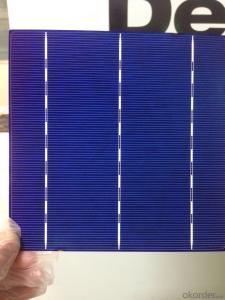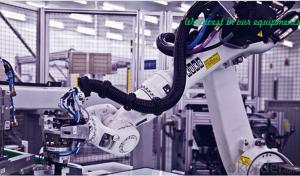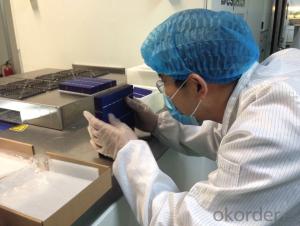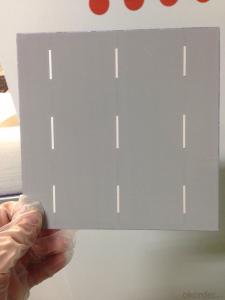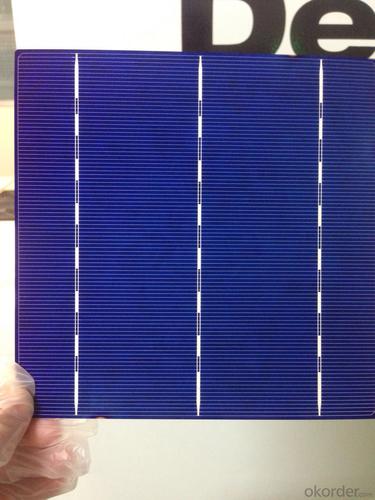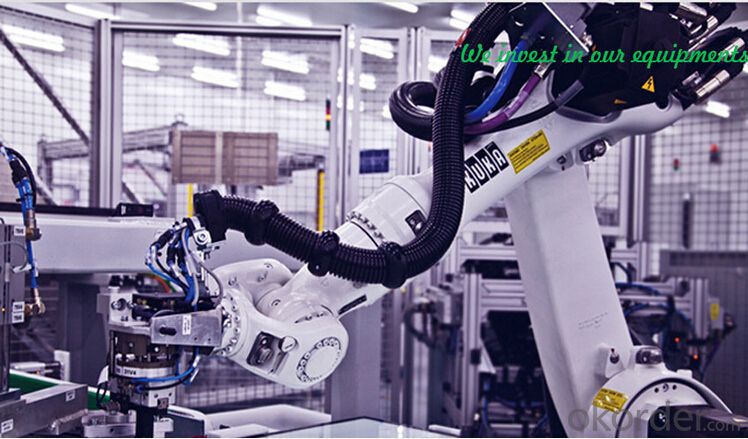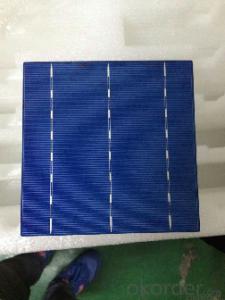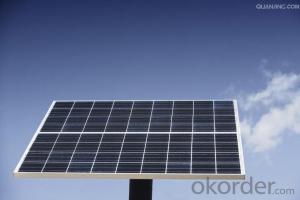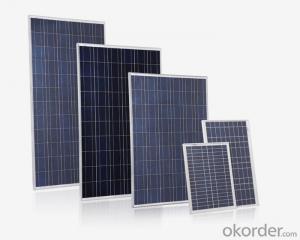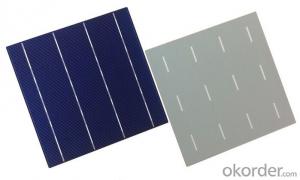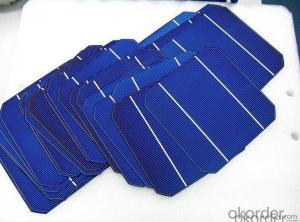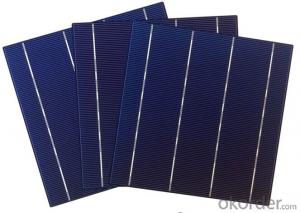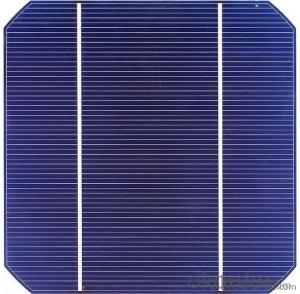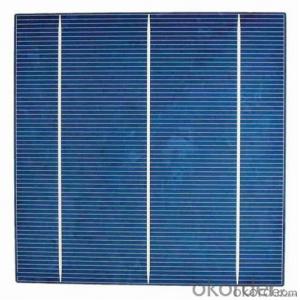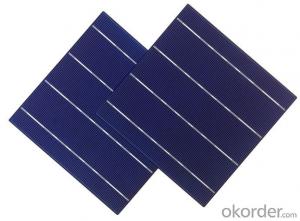Terrestrial Solar Cells - Low Efficiency and Low Power Solar Cells 3bb 17.2%
- Loading Port:
- Shanghai
- Payment Terms:
- TT OR LC
- Min Order Qty:
- 20000 pc
- Supply Capability:
- 2000000 pc/month
OKorder Service Pledge
OKorder Financial Service
You Might Also Like
Specification
Advantages of Poly Solar Cells
1. High efficiency and High power.
2. Long-term electrical stability.
3. Lowest price and Fastest delivery.
4. Good quality and good service.
5. Bulk supply
6. Good Warranty
7. Big Sale
8. More than 25 years on the lifetime.
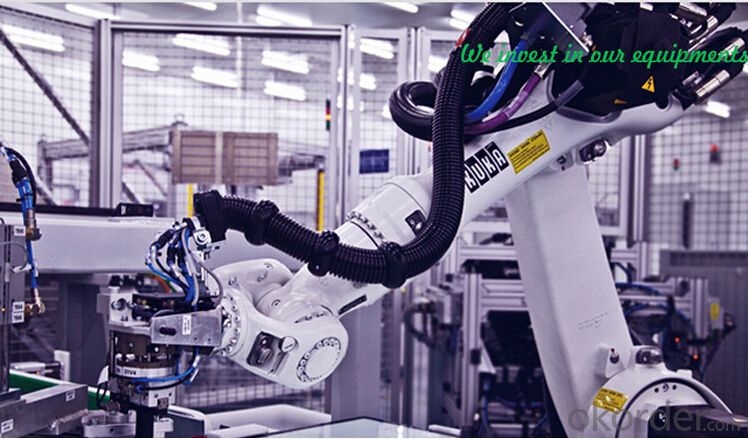

Temperature Coefficient of Monocrystalline Cells
Voc.Temp .coef.%/K:-0.351%/K
Isc.Temp .coef.%/K : +0.035%/K
Pm.Temp. coef.%/K: -0.47%/K
Visual Quality
CNBM Solar sorts cells into four blue color classes and clearly labels them on packaging and shipping documents.
Color uniformity within cells are closely monitored and controlled.
Gives modules a high quality look and feel.
CNBM Solar sets high visual quality standards, screening more than 25 visual criteria.
Performance in High Temperature
CNBM Solar cells produce optimal power output even in high temperature conditions.
Temperature coefficients average 0.1% per °C lower than the competition. This means 3% less power degradation when cell surface temperature increases from 25°C to 55°C.
Performance in Low Light
CNBM Solar Cells perform exceptionally well even in low light.
CNBM Solar A-grade and B-grade cells are screened for shunt resistance.
Higher shunt resistance can result in up to 10% higher annual energy yield for PV systems.
Low Reverse Current
CNBM Solar cells feature low reverse current at both -10V or -12V.
Reduces hot spot risk for long-term reliability.
Environmental Compliance
CNBM Solar cells are developed with environmental protection in mind.
All cells are RoHS compliant.
REACH-SVHC compliance ensures safe entry into the European market.
RoHS compliance: safe limits of Pb and no Cd found.
Usage and Applications of Polycrystalline Cells
Solar cells are often electrically connected and encapsulated as a module. Photovoltaic modules often have a sheet of glass on the front (sun up) side, allowing light to pass while protecting the semiconductor wafers from abrasion and impact due to wind-driven debris, rain, hail, etc. Our Cells can greatly improve the performance of Solar Modules.
Packaging & Delivery of Polycrystalline Cells
Carton Box Package and Deliver by air. It should be noticed that it should be avoid water, sunshine and moist.
FAQ:WHAT'S THE ADVANTAGES OF CNBM?
1.CNBM is a state-owned company under jurisdiction of central goverment , one of Fortune 500 .Just because of this ,we can get more support and resources from our government.So ,it is realiable .
2.CNBM's solar products are high-qualified with TUV,UL,VDE,CE,ISO certificates. Our products ranges top in China.
3.Just as I mentioned in attahment ,we signed 500MW project with Urkan under the witness of our chairman Xi Jinping ,CNBM has ability to meet your large quantity needs,Our annual capacity is 1GW.
FAQ: How many kinds of solar cells can we produce?
•: We can supply the normal 2 kinds of solar cells, Poly 156mm*156mm and Mono125mm*125mm , and the special demension also can be produced .
FAQ:What's the effeciency range of the solar cells?
•: We can supply 16.8% to 18.9% effeciency of the solar cells.
Cell-To-Module Performance (CTM)
1.CNBM Solar improves cell-to-module ratio by:
2.Narrowing down efficiency bin range to 0.2%.
3.Defining efficiency bins by minimal power and 97% of current at maximum power.
4.Customers can manage and control module power output distribution.
5.Customers get more value for their money.
6.Long-Term Reliability
7.High Shunt Resistance
8.Low LID (Light-Induced Degradation)
9.Frequent internal monitoring of LID.
- Q: How do solar cells generate electricity?
- Solar cells generate electricity through a process called the photovoltaic effect. When sunlight hits the solar cell, it excites the electrons in the cell's semiconductor material, causing them to flow and create an electric current. This current is then captured and can be used to power various devices or stored in batteries for later use.
- Q: How do solar cells handle partial shading?
- Solar cells are designed to handle partial shading by utilizing bypass diodes. These diodes allow the current to bypass the shaded cells, ensuring that the unshaded cells continue to generate power. This helps to minimize the impact of shading on the overall efficiency of the solar panel.
- Q: What is a monocrystalline Silicon Solar Cells?
- Monocrystalline Silicon Solar Cells consist of silicon in which the crystal lattice of the entire solid is continuous, unbroken to its edges, and free of any grain boundaries. Mono-Si can be prepared intrinsic, consisting only of exceedingly pure silicon, or doped, containing very small quantities of other elements added to change its semiconducting properties.
- Q: What is the impact of wind on solar cell efficiency?
- The impact of wind on solar cell efficiency is generally minimal. While strong winds can cause slight vibrations in solar panels, it does not significantly affect the overall efficiency of the cells. In fact, a gentle breeze can even help to keep the panels cool, preventing overheating and potentially improving their performance. However, extreme winds or storms can pose a risk of physical damage to the panels, which could impact their efficiency if not properly addressed.
- Q: Can solar cells be used for powering remote weather monitoring stations?
- Yes, solar cells can be effectively used for powering remote weather monitoring stations. Solar cells have the capability to convert sunlight into electrical energy, making them an ideal and sustainable power source for remote locations. They can provide a reliable and continuous power supply to weather monitoring stations, allowing them to operate independently without the need for grid connections or frequent battery replacements. Additionally, solar cells are environmentally friendly and cost-effective in the long run, making them a popular choice for powering off-grid weather monitoring stations.
- Q: Can solar cells be used to power farms or agricultural operations?
- Yes, solar cells can be used to power farms or agricultural operations. Solar energy can be harnessed through solar panels or solar arrays to generate electricity, which can then be used to power various farming activities such as irrigation systems, livestock operations, or running farm machinery. Solar power offers a sustainable and environmentally friendly alternative to traditional energy sources, reducing reliance on fossil fuels and contributing to the overall sustainability of agricultural practices.
- Q: How do solar cells handle power factor correction?
- Solar cells do not handle power factor correction directly. Power factor correction is typically addressed at the level of the grid or inverter systems that convert the DC power generated by solar cells into AC power for use in homes and businesses. However, advanced inverter technologies used in solar power systems can incorporate power factor correction capabilities to improve the overall efficiency and power quality of the system.
- Q: What is the impact of dust storms on solar cell efficiency?
- Dust storms have a negative impact on solar cell efficiency. The accumulation of dust particles on the surface of solar panels obstructs sunlight from reaching the photovoltaic cells, reducing their ability to convert sunlight into electricity. This dust buildup decreases the overall power output of the solar panels and requires regular cleaning and maintenance to maintain optimal efficiency.
- Q: Can solar cells be used in space stations?
- Yes, solar cells can be used in space stations. In fact, they are extensively used to generate electricity in space stations such as the International Space Station (ISS). Solar cells capture sunlight and convert it into electricity, providing a reliable and sustainable source of power for various systems and experiments onboard the space station.
- Q: What are the safety considerations for installing solar cells?
- Some safety considerations for installing solar cells include ensuring proper grounding and bonding to prevent electrical shock hazards, following manufacturer's guidelines for installation to prevent fire hazards, and using personal protective equipment when working at heights or handling equipment to prevent falls or injuries. Additionally, it is important to be aware of potential electrical and fire hazards during installation and maintenance, and to have a plan in place for emergency response.
Send your message to us
Terrestrial Solar Cells - Low Efficiency and Low Power Solar Cells 3bb 17.2%
- Loading Port:
- Shanghai
- Payment Terms:
- TT OR LC
- Min Order Qty:
- 20000 pc
- Supply Capability:
- 2000000 pc/month
OKorder Service Pledge
OKorder Financial Service
Similar products
Hot products
Hot Searches
Related keywords
